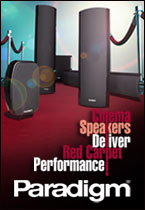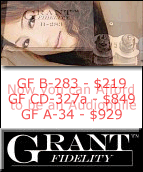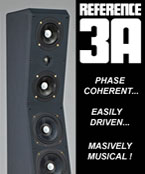
Did you get the memo about speaker design? The one that stated that drivers and cones are supposed to be contained within a boxy enclosure, made of medium density fiber (MDF) and finished in some sort of wood grain.
No? Neither did the guys behind these speakers.
Blueroom speakers were originally an offshoot of the British Bowers & Wilkins speaker company. B&W’s best developers were assigned the task of designing quality sounding speakers at an attainable price. Drawing inspiration from the famed Nautilus line, their first effort, the Minipods, was a well received and successful eye catching product.
The Danish company, Scandyna, now holds the license for manufacturing and marketing the Pod Speaker product line. They have continued the tradition of cyberorganic aesthetics with the recent introduction of the Micropod speakers.
The curvaceousness of these speakers isn’t just eye candy. Round is more rigid. Also, the lack of parallel surfaces reduces internal reflections that can otherwise colour the sound. You may have also noticed a recent trend in speaker design that has the tweeter sitting atop the main speaker cabinet in a rounded off enclosure. This is to reduce diffraction around the edges that also colours the sound. The Micro Pods take this principle and apply it like no other.
Our silver test-set consisted of five identical Micropods and a matching Microsub.
Each 2-way Micropod consists of a 3″ Kevlar midrange driver and a 3/4″ free-mounted tweeter enclosed within a durable ABS plastic shell that is available in white, silver, black and blue. Connections are made via spring loaded posts.
The Microsub is a front firing 8″ driver powered by a built-in 100 watt amplifier. It comes in a matching vented ABS enclosure. The rear panel of the sub includes an RCA line-in that connects directly from your receiver’s sub output. Using this method the crossover is adjusted using the receiver’s bass management feature. Hi-Level spring clip inputs are also on tap, allowing you to connect the front left and right speakers through the subwoofer. This gives you access to the rotary crossover that can be adjusted from 50Hz - 150Hz. The manual recommends that the crossover be set at 120Hz. There is also a volume control knob, a power switch, and a fuse.
We set up the Micropods in our smaller listening area, appropriate for speakers of this size. Connecting them to our Onkyo TX-SR701 was a cinch. The spring loaded terminals accept bare wire, pin or banana plugs. Make no mistake, these aren’t five way binding posts, but being able to actually see how the connection is being made is more reassuring than sticking bare wire into more traditional spring clips and hoping for the best.
Inserting the three plastic “sputnik” spikes into the base of the speakers took a bit of delicate force. Once they were in, they were quite secure and gave the speakers a miniature space probe look. Another attractive option is a specially designed wall bracket, curved of course. Word has it that the Micropods will soon be available in a wireless configuration for the rear surrounds.
The Microsub wasn’t fussy at all. We connected it to the RCA in, from the LFE out on the receiver, placed it between the front-right and centre speaker and pointed it at our sweet spot. We found that setting the volume at 70% blended the Microsub appropriately with the Micropods.
It must be said that these speakers have an impedance of 4ohms, but the TX-SR701 had no trouble with the current demands.
So, how did the package sound? In a word: Refined.
The soundstage was substantial. The highs weren’t harsh. The mids were clear. The lows were tight.
The sub wasn’t able to go deep into the depths of bass-dom but it never lost its composure, and matched up well with the Pods when crossed over at 110Hz. During our movie watching it energized our small room well.
The first DVD we watched was The Animatrix. A benefit of using five identical speakers is that they have the same acoustic properties and their timbres match. We were immediately immersed in the sound. Transition from left to right through the centre channel were smooth and the surrounds handled the ambient effects well.
Kill Bill Vol. 1 has become a favorite of mine. The first fight sequence contains a lot of shattering glass that at times sounded a bit shrill on other speakers, but was more pleasantly laid back on the Micropods.
Other movies with more intense sound effects, really put the little speakers to the test. The Micropods’ rendition of the Pearl Harbor soundtrack, while not jaw dropping, was more than adequate for such diminutive speakers. The Microsub performed well in the bottom end with tightness, quick transitions and rattle-free performance.
We listened to a wide variety of music in the time we spent with this package. We hosted Kurt Cobain’s melancholy, Diana Krall swooned, Louis Armstrong blasted, the Buena Vista Social Club visited and Depeche Mode took us back in time to the late 80s.
Stereo imaging was consistent, the soundstage was beyond what we expected and the sound was again laid back. Extended listening sessions weren’t at all tiring. In fact, we enjoyed these little guys so much that for a while we set them up as computer speakers.
If you’re looking for designer styling and quality sound for a smaller listening area, make sure to give these lunar landers a listen. Blueroom speakers are some of the most unique high-tech looking speakers out there, and they’re guaranteed to modernize any listening space. At $1100, they don’t carry a designer price tag either.
Manufacturer:
Scandyna International
www.podspeakers.com
System Price:
$1100 (Canadian)
Micropods
power handling: 15-100 watts
impedance: 4 ohms
frequency response: 90 Hz - 25 kHz
sensitivity: 87 db / 1 watt / 1 meter
dimensions (HxWxD): 150mm (185 with spikes) x 130mm x 120mm
colours: silver, blue, white, black
Microsub
amplifier : 100 watts
variable crossover: 50 - 100 Hz
dimensions (HxWxD): 360mm x 300mm x 370mm
colours: silver, blue, white, black
Click here to discuss this article on the CANADA HiFi Forum











